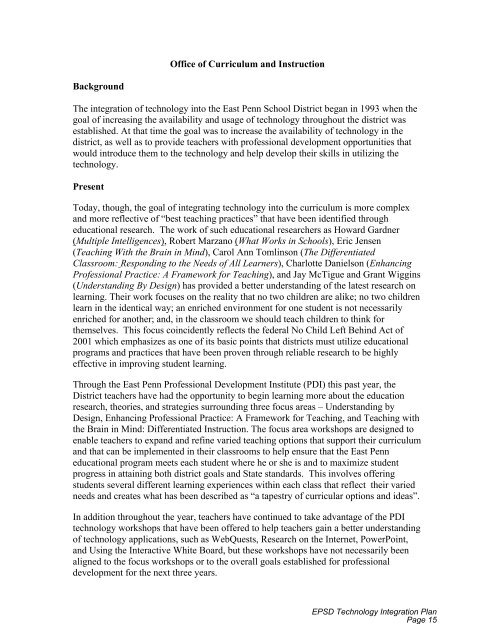EPSDtechintplan2004
EPSDtechintplan2004
EPSDtechintplan2004
You also want an ePaper? Increase the reach of your titles
YUMPU automatically turns print PDFs into web optimized ePapers that Google loves.
Background<br />
Office of Curriculum and Instruction<br />
The integration of technology into the East Penn School District began in 1993 when the<br />
goal of increasing the availability and usage of technology throughout the district was<br />
established. At that time the goal was to increase the availability of technology in the<br />
district, as well as to provide teachers with professional development opportunities that<br />
would introduce them to the technology and help develop their skills in utilizing the<br />
technology.<br />
Present<br />
Today, though, the goal of integrating technology into the curriculum is more complex<br />
and more reflective of “best teaching practices” that have been identified through<br />
educational research. The work of such educational researchers as Howard Gardner<br />
(Multiple Intelligences), Robert Marzano (What Works in Schools), Eric Jensen<br />
(Teaching With the Brain in Mind), Carol Ann Tomlinson (The Differentiated<br />
Classroom: Responding to the Needs of All Learners), Charlotte Danielson (Enhancing<br />
Professional Practice: A Framework for Teaching), and Jay McTigue and Grant Wiggins<br />
(Understanding By Design) has provided a better understanding of the latest research on<br />
learning. Their work focuses on the reality that no two children are alike; no two children<br />
learn in the identical way; an enriched environment for one student is not necessarily<br />
enriched for another; and, in the classroom we should teach children to think for<br />
themselves. This focus coincidently reflects the federal No Child Left Behind Act of<br />
2001 which emphasizes as one of its basic points that districts must utilize educational<br />
programs and practices that have been proven through reliable research to be highly<br />
effective in improving student learning.<br />
Through the East Penn Professional Development Institute (PDI) this past year, the<br />
District teachers have had the opportunity to begin learning more about the education<br />
research, theories, and strategies surrounding three focus areas – Understanding by<br />
Design, Enhancing Professional Practice: A Framework for Teaching, and Teaching with<br />
the Brain in Mind: Differentiated Instruction. The focus area workshops are designed to<br />
enable teachers to expand and refine varied teaching options that support their curriculum<br />
and that can be implemented in their classrooms to help ensure that the East Penn<br />
educational program meets each student where he or she is and to maximize student<br />
progress in attaining both district goals and State standards. This involves offering<br />
students several different learning experiences within each class that reflect their varied<br />
needs and creates what has been described as “a tapestry of curricular options and ideas”.<br />
In addition throughout the year, teachers have continued to take advantage of the PDI<br />
technology workshops that have been offered to help teachers gain a better understanding<br />
of technology applications, such as WebQuests, Research on the Internet, PowerPoint,<br />
and Using the Interactive White Board, but these workshops have not necessarily been<br />
aligned to the focus workshops or to the overall goals established for professional<br />
development for the next three years.<br />
EPSD Technology Integration Plan<br />
Page 15


